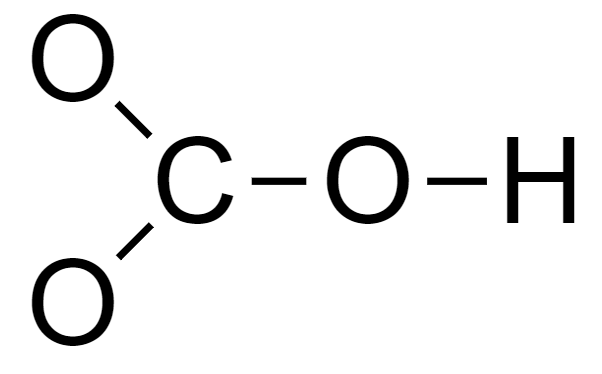
What is the Lewis structure for bicarbonate?
Answer
432.9k+ views
Hint: To solve this question we first need to know what are Lewis dot structures. The valence electrons of the atoms of a molecule can be represented using the Lewis dot structure. They are a simplified version of the molecular geometry of a compound and can be used to depict the chemical bonding in the molecules.
Complete answer:
Bicarbonate, also known as hydrogen carbonate, is formed when carbonic acid is deprotonated. It is an anion having a formula
The Lewis dot structure of a compound can be drawn by the following steps.
1. We first need to know the valence electrons in the atoms of the molecule.
And the molecule has a negative charge, i.e., 1 electron.
Hence the total number of valence electrons is
2. Identify the least electronegative atom. This atom is the central atom of the molecule.
Carbon is the least electronegative atom in
3. Connect the atoms via single bonds to form a skeleton structure.

4. Complete the octet of each element.
The two O atoms bonded only to the C atom need 6 electrons each to complete their octet.
The C atom needs 2 electrons to complete its octet.
The O atom bonded to 1 C atom and 1 H atom needs 4 electrons to complete its octet.
The outermost shell of the H atom is complete.
So the total number of electrons required is 18 whereas the available electrons are 16.
Octet can be completed by forming a double bond as follows

5. Assign lone pairs and the negative charge to the molecules.

Hence the Lewis structure of bicarbonate is as above.
Note:
It should be noted that in sodium hydrogen carbonate, the hydrogen atom is attached to one of the oxygen atoms. Hence, we can assume that in hydrogen carbonate
Complete answer:
Bicarbonate, also known as hydrogen carbonate, is formed when carbonic acid is deprotonated. It is an anion having a formula
The Lewis dot structure of a compound can be drawn by the following steps.
1. We first need to know the valence electrons in the atoms of the molecule.
And the molecule has a negative charge, i.e., 1 electron.
Hence the total number of valence electrons is
2. Identify the least electronegative atom. This atom is the central atom of the molecule.
Carbon is the least electronegative atom in
3. Connect the atoms via single bonds to form a skeleton structure.

4. Complete the octet of each element.
The two O atoms bonded only to the C atom need 6 electrons each to complete their octet.
The C atom needs 2 electrons to complete its octet.
The O atom bonded to 1 C atom and 1 H atom needs 4 electrons to complete its octet.
The outermost shell of the H atom is complete.
So the total number of electrons required is 18 whereas the available electrons are 16.
Octet can be completed by forming a double bond as follows

5. Assign lone pairs and the negative charge to the molecules.

Hence the Lewis structure of bicarbonate is as above.
Note:
It should be noted that in sodium hydrogen carbonate, the hydrogen atom is attached to one of the oxygen atoms. Hence, we can assume that in hydrogen carbonate
Recently Updated Pages
Master Class 9 General Knowledge: Engaging Questions & Answers for Success

Master Class 9 English: Engaging Questions & Answers for Success

Master Class 9 Science: Engaging Questions & Answers for Success

Master Class 9 Social Science: Engaging Questions & Answers for Success

Master Class 9 Maths: Engaging Questions & Answers for Success

Class 9 Question and Answer - Your Ultimate Solutions Guide

Trending doubts
State and prove Bernoullis theorem class 11 physics CBSE

What are Quantum numbers Explain the quantum number class 11 chemistry CBSE

Write the differences between monocot plants and dicot class 11 biology CBSE

Who built the Grand Trunk Road AChandragupta Maurya class 11 social science CBSE

1 ton equals to A 100 kg B 1000 kg C 10 kg D 10000 class 11 physics CBSE

State the laws of reflection of light




